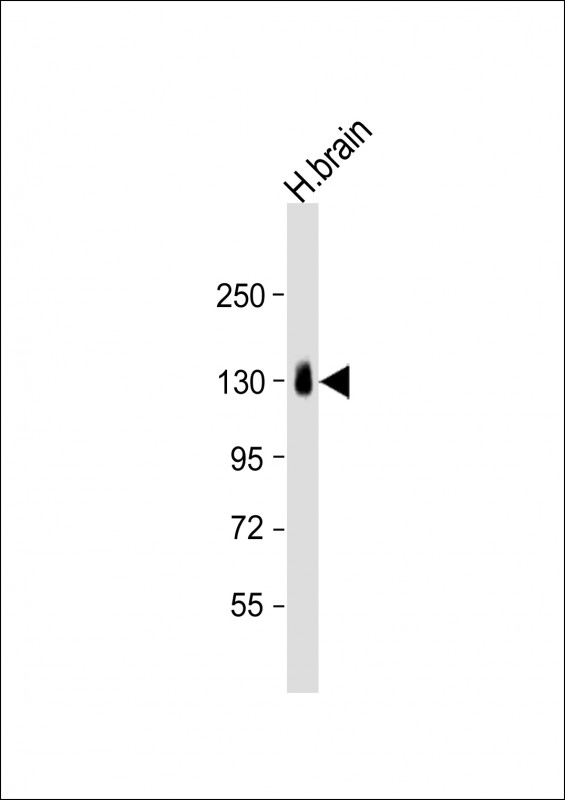CNTN1 Antibody (Center)
Affinity Purified Rabbit Polyclonal Antibody (Pab)
- SPECIFICATION
- CITATIONS
- PROTOCOLS
- BACKGROUND

Application
| WB, E |
|---|---|
| Primary Accession | Q12860 |
| Other Accession | Q63198, P12960, Q28106 |
| Reactivity | Human |
| Predicted | Bovine, Mouse, Rat |
| Host | Rabbit |
| Clonality | Polyclonal |
| Isotype | Rabbit IgG |
| Calculated MW | 113320 Da |
| Antigen Region | 635-662 aa |
| Gene ID | 1272 |
|---|---|
| Other Names | Contactin-1, Glycoprotein gp135, Neural cell surface protein F3, CNTN1 |
| Target/Specificity | This CNTN1 antibody is generated from rabbits immunized with a KLH conjugated synthetic peptide between 635-662 amino acids from the Central region of human CNTN1. |
| Dilution | WB~~1:1000 E~~Use at an assay dependent concentration. |
| Format | Purified polyclonal antibody supplied in PBS with 0.09% (W/V) sodium azide. This antibody is purified through a protein A column, followed by peptide affinity purification. |
| Storage | Maintain refrigerated at 2-8°C for up to 2 weeks. For long term storage store at -20°C in small aliquots to prevent freeze-thaw cycles. |
| Precautions | CNTN1 Antibody (Center) is for research use only and not for use in diagnostic or therapeutic procedures. |
| Name | CNTN1 |
|---|---|
| Function | Contactins mediate cell surface interactions during nervous system development. Involved in the formation of paranodal axo-glial junctions in myelinated peripheral nerves and in the signaling between axons and myelinating glial cells via its association with CNTNAP1. Participates in oligodendrocytes generation by acting as a ligand of NOTCH1. Its association with NOTCH1 promotes NOTCH1 activation through the released notch intracellular domain (NICD) and subsequent translocation to the nucleus. Interaction with TNR induces a repulsion of neurons and an inhibition of neurite outgrowth (By similarity). |
| Cellular Location | [Isoform 1]: Cell membrane; Lipid-anchor, GPI- anchor; Extracellular side |
| Tissue Location | Strongly expressed in brain and in neuroblastoma and retinoblastoma cell lines. Lower levels of expression in lung, pancreas, kidney and skeletal muscle. |

Thousands of laboratories across the world have published research that depended on the performance of antibodies from Abcepta to advance their research. Check out links to articles that cite our products in major peer-reviewed journals, organized by research category.
info@abcepta.com, and receive a free "I Love Antibodies" mug.
Provided below are standard protocols that you may find useful for product applications.
Background
CNTN1 is a member of the immunoglobulin superfamily. It is a glycosylphosphatidylinositol (GPI)-anchored neuronal membrane protein that functions as a cell adhesion molecule. It may play a role in the formation of axon connections in the developing nervous system.
References
Gratacos, M., et al. Am. J. Med. Genet. B Neuropsychiatr. Genet. 150B (6), 808-816 (2009) :
Compton, A.G., et al. Am. J. Hum. Genet. 83(6):714-724(2008)
Melzer, D., et al. PLoS Genet. 4 (5), E1000072 (2008)
If you have used an Abcepta product and would like to share how it has performed, please click on the "Submit Review" button and provide the requested information. Our staff will examine and post your review and contact you if needed.
If you have any additional inquiries please email technical services at tech@abcepta.com.













 Foundational characteristics of cancer include proliferation, angiogenesis, migration, evasion of apoptosis, and cellular immortality. Find key markers for these cellular processes and antibodies to detect them.
Foundational characteristics of cancer include proliferation, angiogenesis, migration, evasion of apoptosis, and cellular immortality. Find key markers for these cellular processes and antibodies to detect them. The SUMOplot™ Analysis Program predicts and scores sumoylation sites in your protein. SUMOylation is a post-translational modification involved in various cellular processes, such as nuclear-cytosolic transport, transcriptional regulation, apoptosis, protein stability, response to stress, and progression through the cell cycle.
The SUMOplot™ Analysis Program predicts and scores sumoylation sites in your protein. SUMOylation is a post-translational modification involved in various cellular processes, such as nuclear-cytosolic transport, transcriptional regulation, apoptosis, protein stability, response to stress, and progression through the cell cycle. The Autophagy Receptor Motif Plotter predicts and scores autophagy receptor binding sites in your protein. Identifying proteins connected to this pathway is critical to understanding the role of autophagy in physiological as well as pathological processes such as development, differentiation, neurodegenerative diseases, stress, infection, and cancer.
The Autophagy Receptor Motif Plotter predicts and scores autophagy receptor binding sites in your protein. Identifying proteins connected to this pathway is critical to understanding the role of autophagy in physiological as well as pathological processes such as development, differentiation, neurodegenerative diseases, stress, infection, and cancer.


